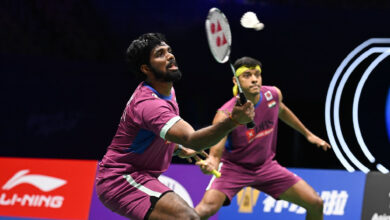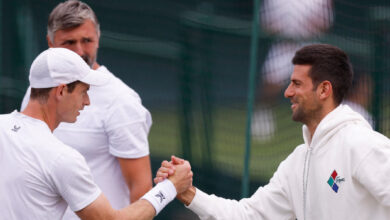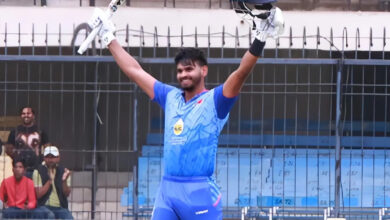Shuttler Ajay Jayaram steps into B-school as life away from court beckons

There was always the geometric incision to Ajay Jayaram’s strokes when he played on the court, and a bunch of cerebral hoodwinks calculated to wrong-foot opponents. But even he was surprised with how much he loved Math. Winding down his career over the European swing of badminton events last autumn, Ajay carried books with his kitbag, and in a matter of few months of prep, was giving his GMAT.A staggering score of 710 would’ve put him in striking dance of a few Ivy League and plenty of other elite business schools abroad.
But the 34-year-old chose a campus he had crossed hundreds of times in his life, at Hyderabad, picking one of India’s finest B-schools, Indian School of Business to transition out of a much-loved sport.“Yes, going abroad was an option. But since my eventual plan was to be in India, it made sense to study here. Also, given my age, I was looking at diverse profiles, so this made more sense,” he says. And he also got a scholarship. The lockdown had led to an interesting va.
“I was always academically inclined in school and college, so studying was more fun than pressure,” says the Mumbai shuttler.
Initially determined to stay motivated when the virus closures hit, tournaments had still not taken off a year after March 2020 the way he liked. He made the Spain semis in one of his last tournaments. “But the tournaments were not enough for a lower ranked player to rise, so motivation weaned off,” says the former Top 15 shuttler.
pic.twitter.com/joc5X0k3Bb
— Ajay Jayaram (@ajay_289) March 26, 2022
Having completed his B.Com after Ruia College, he’d lost touch with classrooms, but had pleasantly discovered a flair for Math (and logical reasoning trick questions). He chuckled at how it was similar to badminton. “I was naturally a fairly deceptive player with good game sense who could create openings. Training under Tom John, I learnt the ability to change speed and play aggressive,” he reckons.
He had sought out the other sporty ISB alumni from Mumbai, Viren Rasquinha, who swapped a hockey stick for powerpoint presentations and networking, donning formals. “He’d gone down a similar path, and said it was a good idea to transition,” Ajay says.
The Verbals half of GMAT had been a tad challenging. “Maths was absolutely fun though it’s tricky and twed, but my concepts were strong. But I had to brush up on English basics. I don’t read excessively, and the colloquial English we speak doesn’t quite wash,” he chuckles. “It’ll be great to come back to sport, but I’m keeping my options open,” he says, having only to decide on electives after the 4th term.Ajay can be credited with kickstarting India’s men’s singles dream season of 2017 – with his Korea Open finals, after which Sai Praneeth, Kidambi Srikanth and HS Prannoy took off in the far east swing. In Korea, Ajay had beaten Viktor Axelsen on the way to making the final. “Against Chou Tien Chen who was the most consent player of that time, I played a near flawless and patient game,” Ajay recalls. A Top 15 entry would follow.
He would also pick back to back Dutch Open titles, yet rue missing out on the hat-trick in the finals the third year. Yet the miss that’ll famously rankle is of the 2012 Olympics qualification, where Parupalli Kashyap pipped him on the last day. “There’s been too many close losses, but that’s the biggest miss,” he states.
None of the last minute heartbreak of a decade ago, dented Ajay’s deep friendship with Parupalli Kashyap. “I think I’ll miss travelling with friends the most about badminton. Kashyap, Anand Pawar, Aditi Mutatkar remain thick friends. Men’s singles has been so competitive all these years, we all travelled together and knew how tough it was to get the breakthroughs. There was maturity about how difficult it is, so that healthy competition helped Kashyap and me stay very close friends and the competition didn’t get in the way of our friendship,” he says.
Injuries though sent Ajay down some dark alleys, especially the ones that quickly followed a high – like the purple patch of 2016 where he made a bunch of quarters and semis, followed a shoulder surgery. And his 2017 peach of a phase after which the hamstring viciously acted up. “I was in the best shape of my life and then the hamstring was the biggest setback. It wasn’t a black & white injury. It kept recurring,” Ajay recalls.
Yet sport taught him to move on with clean breaks. “It teaches you to move to the next thing quickly. Accepting that losses are not the end of the world. And even if you win, you’ll be forgotten in a week and fight the same time next week at another tournament,” he says wisely.Ajay would find for himself quite a reputation as a talented art post 2016, the first of his successful diversions. “I used to draw as a kid. But in 2016 I decided to spend my free time productively. Sketching was a good de-stress.” In the lockdown, he took to painting with passion. He sings too. “It’s just humming,” he says in a conservative estimate, though a guitar hangs on the wall like a prized possession.
For his parents and ser, the emptiness of his wound down and now retired career will be as big a challenge. “Even if I was playing in the US, they’d be up watching at 3 a.m! They lived my career,” he says.
Ajay also ties the knot with Soumya Ravi next week. Slated to start as a product manager with a Bangalore startup, Soumya will help him ease into this transition, he says. “It’ll be impossible when I start college and work to train 5-6 hours a day. But I intend to give it at least a couple of hours a day. I’d love to try out squash and tennis now,” he says.
Badminton that Ajay reckons continues to dawdle in its amateurish bubble could do with a revamp along tennis lines. “I know it’ll take a long long time and it’s probably hard to change the system. But I’d love to take on that challenge,” he says of a future dipping of toes into sport from the other end.As of June, he’ll take the right along the Hyderabad highway, rather than the usual left to the national academy, where he must’ve competed as a player a dozen times. The shuttle court will have fewer of the geometric strides, the angular backhand whips at the net and the suave half-smile of a cerebral takedown on court.







